Column Technologies for the Analysis of Proteins and Their Constituents
Special Issues
Liquid chromatography has long been used for the separation, analysis and purification of biomacromolecules.
Chromatography is well established as a central technology in the separation, analysis, and purification of biological macromolecules. Several forms of chromatography have become mainstays in the analysis of recombinant protein therapeutic drugs. These include reversed-phase high performance liquid chromatography (HPLC), widely used for the analysis of peptide maps; ion exchange for the analysis of charge variants such as glycan sialylation, lysine C-terminal processing, and other protein modifications that cause a change in charge; and size exclusion, widely used for analysis of aggregation and pegylation. Chromatography variations such as hydrophobic interaction chromatography are very useful for the analysis of conjugated proteins, and several forms of chromatography have found places in the analysis of glycosylation. The field of proteomics has also found chromatography useful, particularly for the fractionation of peptides from the digestion of whole proteomes or subsets of these. Specialty forms of chromatography also are useful for protein fractionation based upon specific functional groups such as phosphate or glycosylation.

C. David Carr
Let us look at the current and emerging roles of chromatography in the analysis of proteins, peptides, and amino acids.
Very Small Particle Liquid Chromatography
New territory in the field of HPLC was opened up some years ago with the introduction of very small particles (less than 2 µm), since termed ultrahigh-pressure liquid chromatography (UHPLC). It has long been known that chromatographic performance, as measured by efficiency or resolution, increases as particle size decreases although column back pressure increases. Early totally porous materials were 10 µm in diameter; however, 5-µm diameter particles quickly became the dominant materials for HPLC separations because they offered the ideal tradeoff between column pressure and performance. Nonetheless, it has long been recognized that even smaller particles might offer further improvements in performance; however, the resulting column backpressure has been a significant barrier to their adoption. Very small particles, the so-called sub-2-µm particles, have become more and more popular since their introduction by Agilent Technologies (Santa Clara, California) in 2003 (1), in part because instrumentation now exists to take advantage of these particles but also because chromatographers have recognized that the greatest benefits of these small particles may be less in the increased performance they may have to offer than in the use of shorter columns packed with small particles, resulting in much faster analyses. Time and throughput have become increasingly important in the modern laboratory and very small particles have advanced in usage as a result (3,4).
In the specific field of peptide analysis, especially the analysis of peptides resulting from the digestion of a protein (that is, peptide mapping), very small particles have three distinct and important benefits. First, times of analysis are reduced relative to the use of larger particle materials. This can be significant when one considers that the time required for a full peptide map depends upon the size of the protein being analyzed. Although the peptide maps of small proteins (10,000–20,000 MW) can be analyzed in 45–60 min, the peptide maps of large proteins such as monoclonal antibodies may require as long as 3 h. As illustrated in Figure 1, a typical peptide map can be completed in approximately half the time using very small particles as opposed to the 3.5-µm materials and even more compared to traditional 5-µm materials. Because peptide maps employ gradients, which are the dominant eluting factors when gradients are employed, throughput improvements are not as great as when using isocratic elution. Nonetheless, significant time improvements are possible with very small particles. Second, even using the short columns commonly used with very small particles, resolution often is improved in comparison with larger particle materials as shown in Figure 2. In peptide maps, improved resolution can result in better identification of protein degradation products and greater detection sensitivity because, in part, small peaks are better resolved from nearly larger peaks.

Figure 1
Third, in addition, the smaller columns commonly used with very small particles result in peaks eluted in much smaller volumes of mobile phase. Because both UV detection and the commonly used MS detectors are concentration-sensitive devices and peptides eluted in smaller volumes are inherently more concentrated, detection sensitivity is enhanced by smaller volume peaks. Greater detection sensitivity results in better detection of protein degradation products (Figure 2). UHPLC and the smaller particles used in this method, therefore, offer shorter analysis times, often better resolution, and increased detection sensitivity in the analysis of protein degradation peptide maps. Very small particle columns are now available from over 20 column manufacturers (2).
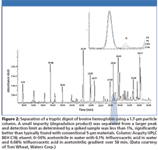
Figure 2
Superficially Porous Silica Materials
One of the ironies noted by long-time liquid chromatographers is the reemergence of superficially porous materials in a modern format after a long absence from the HPLC scene. Many of us began doing HPLC on superficially porous materials (also known as pellicular, controlled-surface porosity, solid-core packings). These early HPLC column materials consisted of glass beads, typically around 40 µm in diameter, coated with a thin (approximately 1–2 µm) coating of porous silica or ion-exchange resin. These were handpacked by chromatographers in the laboratory into relatively long (often 50–100 cm) columns by vibration techniques then commonly used in gas chromatography (GC). Performance compared to modern columns was relatively poor but it was a beginning, and all current LC can trace its roots back to those primitive superficially porous particles. The latest developments in superficially porous materials have come about as a counterpoint to very small particles. Notwithstanding the benefits of very small particles, there are drawbacks. Very small particles do require much higher column pressures, are more demanding of sample preparation techniques to avoid column deterioration and plugging, and are very stringent in their instrumentation requirements, particularly in extra column band broadening and detector response times. It has been found that somewhat larger particle superficially porous materials can mitigate the negative effects of very small particles while offering much of the performance benefits of these particles. Modern superficially porous materials are built on solid, nonporous silica core beads of around 2–4 µm diameter with thin coatings of porous silica around 0.25–0.5 µm, resulting in particles of approximately 2.7–5.0 µm (5).
While the silica coatings used in early superficially porous particles resulted in peak tailing and other effects found with relatively impure Type A silica, modern superficially porous particles are made with very high purity, Type B silica with all of its attendant benefits. These superficially porous particles provide excellent performance while moderating negative effects such as back pressure and have found excellent roles in protein and peptide separations. Superficially porous materials offer the possibility of faster separations at moderate pressures for both peptide maps and for proteins themselves. An excellent separation of the light and heavy chains of a monoclonal antibody is shown in Figure 3 using a 5.0-µm wide pore (300 Å) superficially porous material, Poroshell 300 from Agilent. The separation is accomplished in less than 10 min. Note that the temperature is somewhat elevated. This is important in the analysis of larger, possibly hydrophobic proteins such as antibody light and heavy chains (6).
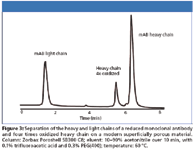
Figure 3
Figure 4 shows the reversed-phase chromatographic separation of a tryptic digest of the protein apotransferrin using modern 2.7-µm superficially porous particles. Using typical 5 µm totally porous particles, the separation of the peptides from this digested protein would generally require 120–150 min. Using the superficially porous particles, the separation required only 15 min, with high resolution. These two examples illustrate the benefits possible with modern superficially porous materials. Superficially porous particles are now available from several column manufacturers, for example, Supelco Ascentis Express (Bellefonte, Pennsylvania), Mac-Mod Halo (Chadds Ford, Pennsylvania), Agilent Poroshell 120 and 300, and Phenomenex Kinetex (Torrance, California).
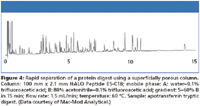
Figure 4
Specialty Columns for Proteins, Peptides, and Amino Acids
Many columns are now available with surface chemistries and other characteristics that allow protein, peptide, and amino acid separations that are specific for certain functional groups or for specific purposes.
Hydrophobic interaction chromatography (HIC) is based upon the salting-out effect long used to fractionate proteins from complex sources such as cell lysates. In HIC the very weakly hydrophobic particle surface is caused by a low surface coverage of C8 or phenyl groups. A mobile phase gradient starts at around 2 M ammonium sulfate, conditions that cause proteins to "salt out" on the weakly hydrophobic surface. Because of the mild conditions, protein tertiary structure is retained. Proteins are then desorbed from the column by reducing the concentration of ammonium sulfate in a reverse gradient. HIC is very effective in the separation of sensitive proteins such as monoclonal antibodies (mABs) whose disulfide bonds have been reduced and drugs conjugated to the resulting free cysteines. These conjugated mABs are a rising star in the fight against cancer and HIC plays an important role in measuring the extent and nature of conjugation. Figure 5 shows the separation of different mAB conjugate variants where the drugs are conjugated to different free cysteines using HIC.

Figure 5
Size-exclusion chromatography (SEC) is the gold standard in the analysis of protein aggregates. Proteins generally have regions that are relatively hydrophobic and these can be exposed through partial denaturation, causing the proteins to self-associate through aggregation. Virtually all proteins aggregate to some extent, although most exhibit aggregation only at the 1–2% level. Aggregate content generally is measured by SEC. New columns developed for SEC are of one of two types: smaller particle size for higher resolution or with specific characteristics for specific purposes. Wyatt Technologies (Santa Barbara, California) has introduced SEC columns (WTC series) with very low bleed specifically for use with light-scattering detection. Light-scattering detectors are a very useful tool used in conjunction with SEC because they provide molecular weight information in addition to detection. Existing SEC columns can bleed and cause interference with light scattering devices. The Wyatt WTC series SEC columns are designed specifically to avoid such problems and are tested to ensure compatibility with light-scattering detectors. Agilent recently has introduced Zorbax Bio SEC columns in a range of particle sizes to provide higher resolution aggregate separations. The use of 3-µm particles improves both peak shape and resolution compared with current SEC columns. Figure 6 shows us that these new, small particles for SEC give high resolution aggregate analysis with an analysis time of about 15 min.
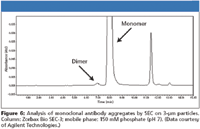
Figure 6
Ion-exchange chromatography is used widely to measure charge variants in proteins, especially in monoclonal antibodies. Many processes, both natural and unnatural, can cause changes in proteins that result in a different charge on the protein. Examples include C-terminal processing by carboxypeptidase enzymes, resulting in the loss of lysine residues (7), changes in the sialic acid content of glycans, pyroglutamate formation on the N-terminus of a protein when glutamine is the N-terminal amino acid and pegylation, resulting in the loss of the positive charge on lysine or the N-terminus. Ion exchange is used to provide a fingerprint of charge variants to ensure reproducibility of production processes. Recent column developments in ion exchange include nonporous particles based upon polystyrene–divinylbenzene (PS-DVB) particles. PS-DVB particles can give rise to nonspecific hydrophobic interactions that broaden peaks and reduce resolution. To avoid nonspecific interactions, the nonporous particles are coated with a hydrophilic layer and then ion-exchange groups are covalently bonded to the surface. Agilent has recently introduced a new series of ion exchange columns based upon this chemistry in particles sizes of 10, 5, 3 and 1.7 µm. The smaller particle sizes provide much higher resolution, improving the separation of the different charge variants. Sepax Technologies (Newark, Delaware) offers nonporous columns designed to separate monoclonal antibodies and other proteins. An example of the separation of a monoclonal antibody using a nonporous ion-exchange column is shown in Figure 7.

Figure 7
Proteomic analysis: Posttranslational modifications such as glycosylation with its attendant sialylation and phosphorylation are important cellular events. Isolating individual phosophopeptides or glycopeptides can reveal much information about what is happening within cells and is an important area of study in proteomics. A number of different chromatography methods and columns have been used over the years to try to isolate modified peptides more accurately. An interesting use of chromatography has been developed recently for this purpose called electrostatic repulsion hydrophilic interaction chromatography (ERLIC) (8). This form of chromatography uses HILIC mobile phase conditions, which cause an aqueous phase to form on the surface of a charged particle. The analyte molecules adsorb into the aqueous phase and can be attracted to or repulsed by the charged surface. In ERLIC, the surface is positively charged, which repels amine groups and attracts negatively charged groups such as phosphate or sialic acid. The combination of effects results in interesting separations of these biologically important molecules.
Amino acid analysis: Amino acids are analyzed today by derivatization with o-phthaldehyde (OPA) or 9-fluorenylmethyl chloroformate (FMOC) and analysis by reversed-phase HPLC. Amino acid analysis also has benefited from the decrease in particle size discussed earlier. New columns packed with C18 reversed-phase materials of very small particles especially prepared for derivatized amino acids permit the analysis in about 7 min (Figure 8).
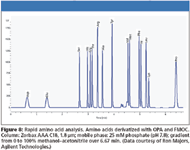
Figure 8
Monolith columns: Monolith columns are made by crosslinking the matrix inside the column, creating a porous rod of matrix. These typically have high throughput at modest pressures. Both silica (Phenomenex, Merck, Darmstadt, Germany) and polymeric columns (Dionex, Sunnyvale, California; BIA Separations, Ljubljana, Slovenia) are available. Monolith columns provide high throughput at lower pressure drops than particulate-based columns and being polymeric, can withstand more aggressive solvent treatment. Ion exchange monoliths have been used for the separation of monoclonal antibodies as well as general protein separations. An interesting application of polymeric monoliths is illustrated in Figure 9, which shows the two-column separation of plasmid DNA starting from a bacterial lysate obtained by an alkaline lysis procedure. After adjustment and clarification, the lysate is injected onto the first column (CIM DEAE, weak anion exchanger) (BIA Separations), where impurities were removed and the pDNA peak collected and then reinjected onto column 2 (CIM C4 HLD, hydrophobic interaction mechanism), where the supercoiled plasmid DNA is separated from the open circular form, genomic DNA and remaining endotoxins. Conditions for the separations are depicted in Figure 9.
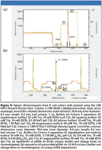
Figure 9
Conclusion
Chromatography continues to be an essential tool in the analysis and study of proteins. Columns capable of isolating proteins or peptides with specific functional groups probably will continue to be developed. The new smaller particle columns and the modern superficially porous particles likely will continue to see expanded use to improve resolution, improve detection limits, and reduce analysis times.
David Carr received his degree from the University of California, Berkeley and has worked in the field of HPLC since 1971. For the past 25 years he has specialized in the analysis and characterization of proteins and peptides by chromatography, capillary electrophoresis and mass spectrometry, first at Vydac and then in his current position as Training Director of Bioanalytical Technologies, a company offering professional development classes to the pharmaceutical and biotechnology industries directed toward the analysis and characterization of protein therapeutic drug products (website at www.bioanalyticaltech.com).
References
(1) R.E. Majors, LCGC 21(3), 240–257 (2003).
(2) R.E. Majors, LCGC supplement Recent Developments in LC Column Technology, 8 (April 2010).
(3) J.R. Mazzeo, U.D. Neue, M. Kele, and R.S. Plumb, Anal. Chem. 77, 460A (2005).
(4) U.D. Neue, M. Kele, B. Bunner, A. Kromidas, T. Dourdeville, J.R. Mazzeo, E.S. Grumbach, S. Serpa, T.E. Wheat, P. Hong, and M. Gilar, "Ultra-Performance Liquid Chromatography Technology and Applications" in Advances in Chromatography, Volume 48, Grushka and Grinberg, Eds. (CRC Press; Boca Raton, Florida, 2010).
(5) J. Kirkland , F.A. Truszkowski, C.H. Dilks Jr., and G.S. Engel, J. Chromatogr., A 890, 3–13 (2000).
(6) T.M. Dillon, P.V. Bondarenko, and M.S. Ricci, J. Chromatogr. 1053, 299–305 (2004).
(7) R.J. Harris, J. Chromatogr., A 705, 129–134 (1995).
(8) A.J. Alpert, Anal. Chem. 80, 62–76 (2008).
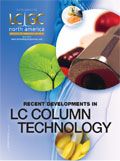
HPLC 2025 Preview: Fundamentally Speaking (Part 1)
May 13th 2025Michael Lämmerhofer from the Institute of Pharmaceutical Sciences, University of Tübingen, Germany, spoke to JFK Huber Lecture Award winner of 2024 Torgny Fornstedt, professor in analytical chemistry and leader of the Fundamental Separation Science Group, Karlstad University, Sweden, about his pioneering work in high performance liquid chromatography (HPLC) with a focus on fundamentals and industrial applications.
Reversed-Phases for LC Deliberately Doped with Positive Charge: Tips and Tricks for Effective Use
May 13th 2025In this month's edition of LC Troubleshooting, Dwight Stoll and his fellow researchers discuss both the benefits (improved peak shape/loading) and challenges (excessive interaction) associated with charge-doped reversed-phase (RP) columns for both analytical and preparative separations.
Determining Ways to Protect Honeybee Colonies with GC–MS
May 13th 2025A study conducted by the Agriculture Research Centre of Giza, Egypt, and Jilin Agricultural University in China, evaluated the efficacy of stinging nettle extract, nettle smoke, and formic acid in the controlling of Varroa mites, a major threat to honeybee colonies, with a focus on mite infestation reduction, honeybee mortality, and biochemical responses. Gas chromatography–mass spectrometry (GC–MS) was used to identify key bioactive compounds in the stinging nettle extract.

.png&w=3840&q=75)

.png&w=3840&q=75)



.png&w=3840&q=75)



.png&w=3840&q=75)










